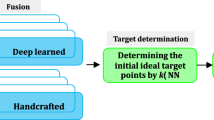Abstract
The advent of ‘Big Data’ and ‘Deep Learning’ offers both, a great challenge and a huge opportunity for personalised health-care. In machine learning-based biomedical data analysis, feature extraction is a key step for ‘feeding’ the subsequent classifiers. With increasing numbers of biomedical data, extracting features from these ‘big’ data is an intensive and time-consuming task. In this case study, we employ a Graphics Processing Unit (GPU) via Python to extract features from a large corpus of snore sound data. Those features can subsequently be imported into many well-known deep learning training frameworks without any format processing. The snore sound data were collected from several hospitals (20 subjects, with 770–990 MB per subject – in total 17.20 GB). Experimental results show that our GPU-based processing significantly speeds up the feature extraction phase, by up to seven times, as compared to the previous CPU system.



Similar content being viewed by others
References
H. Ali (2015) Big data analytics in biomedical informatics, BIOSTEC. Tech Rep
M. S. Kamal and S. F. Nimmy (2016) Strucbreak: a computational framework for structural break detection in dna sequences. Interdiscip Sci 1–16
Grossman R, White K (2012) A vision for a biomedical cloud. J Intern Med 271(2):122–130
Bastrakov S, Meyerov I, Gergel V, Gonoskov A, Gorshkov A, Efimenko E, Ivanchenko M, Kirillin M, Malova A, Osipov G et al (2013) High performance computing in biomedical applications. Procedia Comput Sci 18:10–19
Qian K, Guo J, Xu H, Zhu Z, Zhang G (2014) Snore related signals processing in a private cloud computing system. Interdiscip Sci 6(3):216–221
I. Dogaru and R. Dogaru (2015) Using python and julia for efficient implementation of natural computing and complexity related algorithms. In: 2015 20th International Conference on Control Systems and Computer Science. IEEE, pp. 599–604
Strollo PJ Jr, Rogers RM (1996) Obstructive sleep apnea. N Engl J Med 334(2):99–104
Pevernagie D, Aarts RM, De Meyer M (2010) The acoustics of snoring. Sleep Med Rev 14(2):131–144
Mesquita J, Solà-Soler J, Fiz JA, Morera J, Jané R (2012) All night analysis of time interval between snores in subjects with sleep apnea hypopnea syndrome. Med Biol Eng Computing 50(4):373–381
Abeyratne U, De Silva S, Hukins C, Duce B (2013) Obstructive sleep apnea screening by integrating snore feature classes. Physiol Meas 34(2):99
M. Schmitt, C. Janott, V. Pandit, K. Qian, C. Heiser, W. Hemmert, and B. Schuller (2016) A bag-of-audio-words approach for snore sounds excitation localisation. In: Proceedings of 12th ITG Conference on Speech Communication. pp. 230–234
Qian K, Janott C, Pandit V, Zhang Z, Heiser C, Hohenhorst W, Herzog M, Hemmert W, Schuller B (2017) Classification of the excitation location of snore sounds in the upper airway by acoustic multi-feature analysis. IEEE Trans Biomed Eng 64(8):11
A. Adeshina and R. Hashim (2016) Computational approach for securing radiology-diagnostic data in connected health network using high-performance gpu-accelerated aes. Interdiscip Sci 1–13
Huijie X, Weining H, Yulisheng CL (2011) Spectral analysis of snoring sound and site of obstruction in obstructive sleep apnea/hypopnea syndrome. Am J Audiol Speech Pathol 1:009
Azarbarzin A, Moussavi ZM (2011) Automatic and unsupervised snore sound extraction from respiratory sound signals. IEEE Trans Biomed Eng 58(5):1156–1162
Al-Ameen Z, Sulong G (2015) Deblurring computed tomography medical images using a novel amended landweber algorithm. Interdiscip Sci 7(3):319–325
Van Der Walt S, Colbert SC, Varoquaux G (2011) The numpy array: a structure for efficient numerical computation. Computing Sci Eng 13(2):22–30
E. Jones, T. Oliphant, P. Peterson et al. (2001) Open source scientific tools for python
G. Van Rossum et al. (2007) Python programming language. In: USENIX Annual Technical Conference. vol. 41
Y. Jia, E. Shelhamer, J. Donahue, S. Karayev, J. Long, R. Girshick, S. Guadarrama, and T. Darrell (2014) Caffe: Convolutional architecture for fast feature embedding. In: Proceedings of the 22nd ACM international conference on Multimedia. ACM, pp. 675–678
T. Chen, M. Li, Y. Li, M. Lin, N. Wang, M. Wang, T. Xiao, B. Xu, C. Zhang, and Z. Zhang (2015) Mxnet: a flexible and efficient machine learning library for heterogeneous distributed systems. arXiv preprint arXiv:1512.01274
M. Abadi, A. Agarwal, P. Barham, E. Brevdo, Z. Chen, C. Citro, G. S. Corrado, A. Davis, J. Dean, M. Devin et al. (2015) Tensorflow: large-scale machine learning on heterogeneous systems, Software available from tensorflow. org 1
Bergstra J, Bastien F, Breuleux O, Lamblin P, Pascanu R, Delalleau O, Desjardins G, Warde-Farley D, Goodfellow I, Bergeron A et al (2011) Theano: deep learning on gpus with python, in NIPS 2011. BigLearning Workshop, Granada
Pedregosa F, Varoquaux G, Gramfort A, Michel V, Thirion B, Grisel O, Blondel M, Prettenhofer P, Weiss R, Dubourg V, Vanderplas J, Passos A, Cournapeau D, Brucher M, Perrot M, Duchesnay E (2011) Scikit-learn: machine learning in python. J Mach Learn Res 12:2825–2830
C. Analytics (2015) Anaconda software distribution, Computer software, nov. [Online]. Available: https://continuum.io
K. Qian, C. Janott, Z. Zhang, C. Heiser, and B. Schuller, “Wavelet Features for Classification of VOTE Snore Sounds,” in Proceedings ICASSP.Shanghai, P. R. China: IEEE, 2016, pp. 221–225
Author information
Authors and Affiliations
Corresponding author
Rights and permissions
About this article
Cite this article
Guo, J., Qian, K., Zhang, G. et al. Accelerating Biomedical Signal Processing Using GPU: A Case Study of Snore Sound Feature Extraction. Interdiscip Sci Comput Life Sci 9, 550–555 (2017). https://doi.org/10.1007/s12539-017-0232-9
Received:
Revised:
Accepted:
Published:
Issue Date:
DOI: https://doi.org/10.1007/s12539-017-0232-9




